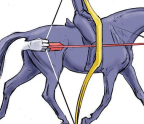Control the Canter for BETTER COURSES

When I was a younger rider in the jumper ring, I felt like I saw every distance perfectly, but I still could have eight faults. I’d watch other riders’ rounds, and sometimes their distances were too long or too deep, but they were jumping clear rounds. The reason was because they created a good canter, giving their horses a chance to gauge the jumps. I think that the biggest myth in the American system is the need to find perfect distances. At an early age, we become so fixated on finding the perfect “x” on the ground to take off from that we’re willing to throw the canter out the window just to get to it. That is not the best chance for success.
If you watch top riders on course, they are in charge of the canter. They start with a canter that has good balance and impulsion—the energy harnessed within the gait—and keep it to the first fence. When they jump a line that requires them to open up the horses’ stride, after it, they immediately collect to return to that base canter. When they jump a line where the striding requires them to collect the horses’ stride, after it, they immediately move the horse up to get back to the base canter.
On the opposite end of the spectrum, I see rounds that become erratic because riders lose track of the canter in search of the distances. The riders might ride a line that is very forward and after it, instead of going back to the base canter, they overcollect the
You’re reading a preview, subscribe to read more.
Start your free 30 days



